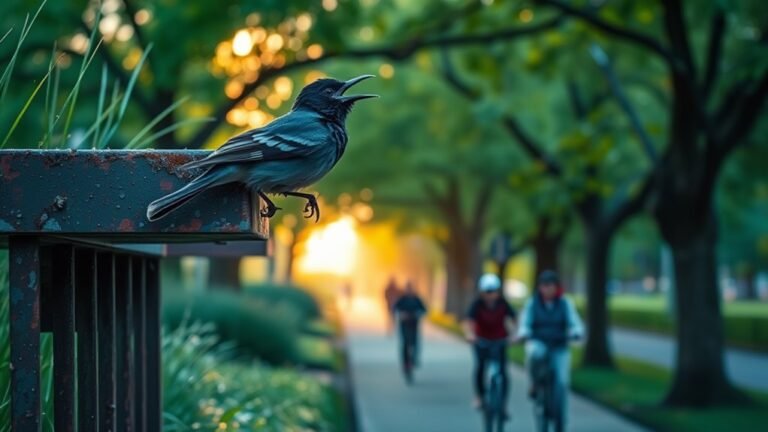Bird That Sounds Like an Alarm: Urban Noises Explained
Have you ever listened to city birds and heard a sound like a car alarm? This is because some birds, like the European starling, mimic urban noises. They do this to communicate and survive. Why do they mimic our sounds? These birds adapt well to the noise made by humans. This ability helps them live better in city environments.
Key Takeaways
Urban birds change their calls to sound like alarm noises. This helps them communicate clearly in noisy city environments. European starlings and American crows often mimic car alarms and other urban sounds.
Birds use vocal mimicry for several reasons. It helps them attract mates and confuse predators, which improves their chances of survival in cities. Noise pollution affects bird communication. To cope with the loud sounds around them, birds adjust the pitch and timing of their songs.
Birds show great resilience by thriving in urban areas, adapting well to the challenges that come from human activities and noise. Their ability to survive and communicate effectively in these settings is fascinating and highlights their adaptability.
The Mystery of the Alarm-Bird: Identifying the Culprit

Have you noticed the loud chirping in the morning? This sound often comes from alarm species, which are birds that live in busy cities.
These birds have special traits that help them thrive in noisy environments. They change their calls to be heard over the sounds of the city, making a unique alarm-like noise. These calls aren't random; they're important for their communication with other birds.
Understanding these birds helps us see their role in the urban ecosystem. They remind us that nature continues to thrive, even in the busy life of the city.
Next time you hear them, consider their adaptability and the way they contribute to their surroundings.
Vocal Mimicry: How Birds Imitate Sounds
Urban areas are filled with human-made sounds. Many birds have learned to imitate these noises, a behavior called vocal mimicry. This ability allows birds to copy various sounds they hear in their surroundings. You might hear them imitating not just other birds, but also mechanical sounds, sirens, and even human voices.
Birds use this imitation for several reasons. It can help them attract mates, mark their territory, or confuse predators and competitors.
This skill shows how adaptable and clever these birds are in urban settings. Through vocal mimicry, birds connect with their environment, making their calls a standout part of the city's soundscape.
The Role of Urban Environments in Bird Behavior

Urban environments affect bird behavior significantly. These settings present both challenges and opportunities for survival. Birds adapt to these environments in various ways. For example, they may change their feeding habits or nesting locations to fit their urban habitats.
Some birds learn to eat food that people discard, while others build nests in buildings instead of trees.
City noise can also affect how birds communicate. They often change their calls to be heard above the sounds of traffic and people.
Understanding these adaptations highlights how birds can thrive despite human changes to their environment. This knowledge connects you to the natural world, even in busy urban settings.
Notable Examples of Alarm-Mimicking Birds
Birds adapt their behaviors to urban noise and display impressive alarm-mimicking traits. The European starling is one such bird. It imitates car alarms and phone ringtones. This mimicry helps it fend off predators while fitting into the noisy urban environment.
The American crow also uses mimicry. It copies various environmental sounds to warn other birds of danger.
These behaviors illustrate how birds adapt to living in cities.
The Impact of Noise Pollution on Bird Communication

As cities become noisier, noise pollution disrupts bird communication and threatens their survival. Birds use vocal sounds to find mates, claim their territory, and alert others to danger. Increased noise from traffic, construction, and other urban activities makes it difficult for birds to communicate properly.
To be heard over the noise, birds often change their songs by singing at higher pitches or altering their timing. These changes can lead to confusion, causing difficulty in communication. This can affect their ability to reproduce and damage social structures among birds, which can harm local ecosystems.
Understanding how noise pollution impacts bird communication helps us realize our role in creating quieter urban spaces. By working towards a more peaceful environment, we can support the well-being of bird communities and enhance our connection with nature.
Coexisting With Nature: Lessons From Urban Wildlife
In urban areas, wildlife adapts to noise and changes in their environment. This adaptability teaches us important lessons about living alongside nature.
Observing various species can help strengthen your connection to the natural world.
- Watching resilient animals can motivate you to engage with nature.
- Learning about wildlife adaptation can build empathy for other living beings.
- Seeing these changes can inspire a sense of duty to protect habitats.
Frequently Asked Questions
What Time of Day Do Alarm-Sounding Birds Typically Vocalize?
Alarm-sounding birds vocalize mainly during dawn and dusk. Their calls peak at sunrise and sunset. During these times, birds mark their territory and communicate with each other. This creates an energetic atmosphere, especially in urban areas.
How Do Urban Birds Adapt to Changes in Their Environment?
Urban birds adapt to their environments by changing their calls. This helps them communicate effectively despite noise from the city. These adjustments support urban biodiversity, allowing birds to thrive and perform their important roles in nature. By modifying how they sound, urban birds can survive and interact with each other better. This adaptability highlights their resilience and ability to integrate into city life.
Are Alarm Sounds Harmful to Bird Populations?
Alarm sounds can change bird populations. They affect communication and breeding. While these sounds are not directly harmful, they can cause stress in birds. This stress may lower survival rates. Over time, these factors can alter bird populations.
Can Other Animals Imitate Human-Made Sounds Like Birds?
Yes, other animals can imitate human-made sounds. This shows their ability to mimic. Urban animals like raccoons and foxes copy noises from their surroundings. They adapt to live and thrive in human environments. This ability helps improve their chances of survival.
Do Alarm-Sounding Birds Prefer Specific Types of Urban Habitats?
Alarm-sounding birds show clear preferences for certain urban habitats. They thrive in areas with many buildings and high noise levels. These birds adapt their calls to communicate effectively in these environments. Their ability to adjust highlights their skill in living alongside humans in cities.

Ava is a bird enthusiast and nature lover who has spent countless hours observing and learning about the fascinating world of birds. With a passion for sharing her knowledge and inspiring others to appreciate the beauty of birds, Ava writes about her experiences and insights on avianadmirer.com.







